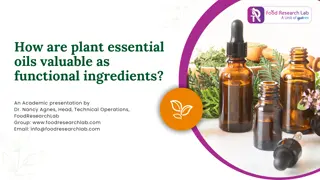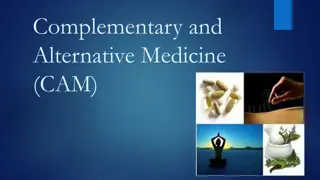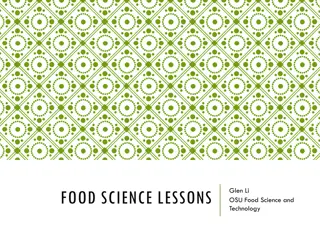Exploring the World of Nutraceuticals: Let Food Be Your Medicine
Nutraceuticals bridge the gap between food and medicine, offering health benefits beyond basic nutrition. Coined in 1989 by Stephen DeFelice, MD, these functional components in food help prevent diseases and promote overall well-being. From fatty acids to dietary fiber, various sources like milk, meat, and whole grains provide nutrients that enhance health. Discover how these natural ingredients can improve body composition, reduce cancer risks, and support a healthy digestive tract.
Download Presentation

Please find below an Image/Link to download the presentation.
The content on the website is provided AS IS for your information and personal use only. It may not be sold, licensed, or shared on other websites without obtaining consent from the author. Download presentation by click this link. If you encounter any issues during the download, it is possible that the publisher has removed the file from their server.
E N D
Presentation Transcript
NUTRACEUTICALS Let Food be Your Medicine G.JENIFA ASST.PROF & HEAD, DEPT OF FOOD SCIENCE AND NUTRITION STC
The term Nutraceutical was coined from Nutrition & Pharmaceutical in 1989 by Stephen DeFelice, MD, Founder and Chairman of the Foundation for Innovation in Medicine (FIM).
The term nutraceutical combines the word nutrient (a nourishing food or food component) with pharmaceutical (a medical drug).
Nutraceutical can be defined as A food or part of food or nutrient, which in addition to its normal nutritional value, provides health benefits including the prevention and treatment of a disease or promotion of health.
Such foods also commonly are referred to as functional foods, all foods are functional in that they provide nutrients, nutraceuticals contain health-promoting ingredients or natural components that have a potential health benefit for the body. . In the early 1900s, food manufacturers in the United States began adding iodine to salt in an effort to prevent goiter (an enlargement of the thyroid gland), representing one of the first attempts at creating a functional component through fortification.
EXAMPLES OF FUNCTIONAL COMPONENTS Class / components Source Potential benefit 1. Fatty acids Milk & Meat Fish oils, maize fodder,mustard,li nseed,rapeseed Improve body composition, reduce cancersReduce CVD & improve mental, visual function
Class / components Source Potential benefit May contribute to maintenance of a healthy digestive tract Reduce breast, colon cancer Dietary Fiber Insoluble fibre:Wheat bran ANd9GcR7dT463fnvvkH5R88NVRnc6B42IjW98mqi9OkvAbq1oLHE2YWxg6MHHg -glucan Whole grain Reduce CVD Oats Cereal grains
Class / components Source Potential benefit Onions, apples, tea, broccoli Neutralize free radicals, which may damage cells; bolster cellular antioxidant defenses Flavonoids Flavonols ANd9GcQPL3gTOLr1I1oGDm-prcyrlNWu5cefdL7DD7Jc1CuL5M0tSjnS_Px0cA ANd9GcRZLgh2leGOvS-dC7aBLBxnzXnwTKGXSwY0x0WXF0zK3emt_eVT2B0zhA ANd9GcRYR91g_eHBMJYv_1pqeE-P0PwrT-pUpNZu03r8wbv6zcQ05hgdZ4sxyyA ANd9GcTG2onEj9AHwldxZuQ_SpGrDdyR3GBBRhsJT65hRUYxmDLgFJE6LgZ6V09s
Class / components Source Potential benefit Phenols Caffeic acid, ferulic acid(Coffee is particularly rich in bound phenolic acids, such as caffeic acid, ferulic acid, ) Apples, pears, citrus fruits, some vegetables May bolster cellular antioxidant defenses; may contribute to maintenance of vision and heart health ANd9GcSrbznoE_JL8CPMK8itm0Je39iQqCF3TK_SkOT2T8e8gXSMHXv0ofE4nQ ANd9GcR7j7aug3FtUFYYWHmKfRWqp8hDnCBpzxOcb4x2gHCJsg0EbMF1ROPORg
Class / components Source Potential benefit Polyols chewing gums and other food applications Sugar alcohols (xylitol, sorbitol, mannitol, lactitol) May reduce risk of dental caries (cavities Some
Class / components Source Potential benefit Soybeans and soy-based foods May contribute to maintenance of bone health, healthy brain and immune functions; for women, maintenance of menopausal health Phytoestrogen s Isoflavones (daidzein, genistein) ANd9GcQcF245EF6XHfyu484Db-v-QdnHufiWEw-UO08IO4_dGTVOQah5TwLWHlKu
NUTRACEUTICALS AVAILABLE IN MARKET Brand name Components Function Betatene Carotenoids Immune function Xangold Lutein esters Eye health -lipoic acid Lipoec Potent antioxidant CHD reduction Generol Phytosterol Premium probiotics Soylife probiotics Intestinal disorder Bone health Soyabean phytoestrogen
NUTRACEUTICALS AVAILABLE IN MARKET Brand name Components Function Z-trim Wheat Zero calorie fat replacer Prostate health Linumlife Lignan extract flax Fenulife Fenugreek galactomannon Control blood sugar Teamax Green tea extract Potent antioxidant 3 FA, DHA, EPA Marinol Heart health protection Weight loss ingredient Reduce cholesterol Clarinol CLA Cholestaid Saponin
Broadly can be defined as: Nutrients: Substances which have established Nutritional functions e.g. Vitamins, Minerals, Amino Acids, Fatty acids, etc. Herbals/ Phytochemicals: Herbs or Botanical products Dietary Supplements: Probiotics, Prebiotics, Antioxidents, Enzymes, etc.
NUTRIENTS Most common Nutrients used/ supplemented as Nutraceutical are: Minerals and Vitamins. or in combination or in combination with other antioxidants
Health Benefits of different common nutrients Vitamins Fat Soluble Vitamins Vitamin A: Acts as antioxidant, essential for growth and development, maintains healthy vision, skin and mucous membranes, may aid in the prevention and treatment of certain cancers and in the treatment of certain skin disorders.
Vitamin D: Essential for formation of bones and teeth, helps the body to absorb and use calcium Vitamin E: Antioxidant, helps to form blood cells, boosts immune system Vitamin K: Essential for blood clotting
Water Soluble Vitamins Vitamin C: Antioxidant, necessary for healthy bones, gums, teeth and skin. Helps in wound healing, prevent from common cold Vitamin B 1: Helps in carbohydrate metabolism, essential for neurological function. Vitamin B 2: Energy metabolism, maintain healthy eye, skin and nerve function.
Vitamin B 3: Energy metabolism, brain function Vitamin B 6: Helps to produce essential proteins, convert proteins to energy Vitamin B 12: Help in producing genetic material, formation of RBC, maintenance of CNS, synthesis of amino acids, involved in metabolism of protein, fat and carbohydrate.
Folic acid: Helps in RBC formation, formation of genetic material of cell, very much essential during pregnancy Pantothenic acid: Aids in synthesis of cholesterol, steroids, and fatty acids, crucial for intraneuronal synthesis of acetylcholine
Vitamins like Compounds L- Carnitine: Helps in oxidation of fatty acids, role in oxidative phosphorylation, Choline: Lipotropic agent, used to treat fatty liver and disturbed fat metabolism, Inositol: For amino acid transport and movement of Potassium and sodium, Taurine: Helps in retinal photoreceptor activity, bile acid conjugation, WBC antioxidant activity, CNS neuromodulation, platelet aggregation, cardiac contractibility, sperm motility, insuline activity,
Minerals: Calcium: essential for bone and teeth, maintaining bone strength, nerve, muscle and glandular function, blood clotting, Iron: energy production, Hb, oxygen transport, Magnesium: for healthy nerve and muscle function, bone formation, Phosphorous: energy production, phosphorylation process, bone and teeth, for genetic material,
Cobalt: component of Vit. B 12 and B 12 coenzymes, Copper: Hb and collagen production, function of heart, energy production, absorption of Iron, Iodine: proper function of Thyroid gland, Chromium: with insulin it helps in conversion of carbohydrate and fat into energy, treatment of diabetes,
Selenium: Antioxidant, functioning of heart muscle, part of GPX enzyme, Zinc: Essential for cell reproduction, for development in Neonates, wound healing, production of sperm and testosterone hormone,
Herbals: Aloe vera: Anti-inflammatory, emollient, wound healing, Evening Primrose oil: Dietary supplement of linoleic acid, treatment of atopic eczema, Garlic: Antibacterial, antifungal, antithrombotic, antiinflammatory, Ginger: carminative, antiemetic, treatment of dizziness
Ginseng: Adaptogen, Green tea: Antioxidant, reduces risk of CVD, enhances humoral and cell mediated Immunity, Vegetables, fruits, whole grain, herbs, nuts and various seeds contain an abundance of phenolic compounds, terpenoids, sulphur compounds, pigments etc. that has been associated with protection / treatment of certain disease conditions,
Phytochemicals: Phytochemicals could provide health benefits as: 1. Substrate for biochemical reactions 2. Cofactors of enzymatic reactions 3. Inhibitors of enzymatic reactions 4. Absorbents that bind to & eliminate undesirable constituent in the intestine 5. Scavengers of reactive or toxic chemicals
6. Enhance the absorption and / or stability of essential nutrients 7. Selective growth factor for beneficial bacteria 8. Fermentation substrate for beneficial bacteria 9. Selective inhibitors of deleterious intestinal bacteria
Various Phytochemicals Phytochemicals Source Role Tocotrienols & tocopherols Grains Suppressed the growth of diverse tumors cell lines via initiation of apoptosis and concomitant arrest of cells in the G1 phase of the cell cycle Antioxidants, protects against uterine, prostate, colorectal, lung and digestive tract cancers, and protection to other antioxidants. Carotenoids Fruits & vegetables
Limonoids Citrus fruits Inducing detoxification enzymes in liver, provide protection to lung tissue. Exhibit anti-inflammatory, anti-neoplastic, anti- pyretic & immune- modulating activity, decrease cholesterol Antioxidants, lowers the risk of CHD, diabetes, hypertension etc. Phytosterols Various plants Phenolic constituents Various plants, wholegrain
Flavonoids Grapes, wines Action against free radicals, free radicals mediated cellular signaling, inflammation, allergies, platelet aggregation, & hepatotoxins Grapes, berries, cocoa, green tea, acacia spp. eicosanoid synthesis, reduces CHD Soybeans Treating cancers & osteoporosis Catechin & gallic acids Antioxidants, free radical scavenging ability, inhibition of Isoflavonoids
Anthocyanidins Fruits & flowers Antioxidants & anti- mutagenic properties Activators of liver detoxification enzymes, inhibit the neoplastic effect of various carcinogens Reduces estrogen- dependent cancer risk, Protects against colorectal diseases, Glucosinolates Cruciferous Indoles Fiber Various vegetables, fruits,
Method to enhance active components in food Manipulating the diet to get maximum level of active components Combination of food ingredients rich in nutraceuticals Fortifying food with active ingredients By fermentation of food products Changing food habits to natural type of diet
CONCLUSION Nutraceuticals are present in most of the food ingredients with varying concentration Concentration, time and duration of supply of nutraceuticals influence human health Manipulating the foods, the concentration of active ingredients can be increased Diet rich in nutraceuticals along with regular exercise, stress reduction and maintenance of healthy body weight will maximise health and reduce disease risk























